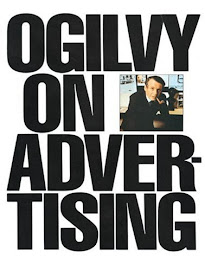
Ogilvy On Advertising
By David Ogilvy
by Michael C. Gray
August 30, 1999
August 30, 1999
David Ogilvy’s life is inspirational. He was a college dropout, former chef and former door-to-door salesman who became a copywriter and founded the largest advertising agency in the world. So, when David Ogilvy writes about advertising, it is well worth studying what he has to say.
This book could well be titled, "What Works In Advertising."
David Ogilvy did not believe that advertising should be totally guesswork. His firm, Ogilvy and Mather, conducted extensive research on what really works, and then shared their findings with the world. It is amazing how the advertising industry has ignored this information. Ogilvy also believed that people who are interested in advertising as a career should become students of advertising. Advertising executives who refuse to study the principles of the profession are as foolish as a person who hangs a shingle to practice medicine without going to medical school and studying medical developments. On the other hand, he found the quality of coursework and textbooks on advertising at universities to be poor.
He believed people who enter the advertising profession should work in direct response advertising for at least a year to learn techniques that really work. Direct response advertising is the only type that produces measurable results.
Here are a few of the principles for print ads that Ogilvy shares in his book.
1. Layout. A reader’s eye tends to look first at an illustration, second at the headline, third at a caption under the illustration, fourth to the copy. Therefore, the layout should be illustration first, every illustration should have a caption, headline second, copy third.
2. Typestyle. Serif typestyles are the easiest to read (they are typically used in books for this reason.) Use serif typestyles for your ads. Words with all capital letters are also hard to read. The eye tends to read "all caps" one letter at a time. Use upper and lower case.
3. Reverse. White letters on a black or dark background is almost impossible to read. Use it sparingly. If a newspaper or magazine requires you to "flag" an advertisement, write "advertisement" at the top in reverse, using italics. It is impossible to read and therefore practically invisible.
4. Subheads. A subhead between the headline and body copy builds readership. For long copy, additional subheads throughout the copy helps retain interest.
Drop-initials. "If you start your body copy with a drop-initial, you increase readership by an average of 13 percent."
Drop-initials. "If you start your body copy with a drop-initial, you increase readership by an average of 13 percent."
5. Number points. "If you have a lot of unrelated facts to recite, don’t use cumbersome connectives. Simply number them."
Space between paragraphs. Using a space between paragraphs increases readership by an average of 12 percent.
Sex in advertising. "Some copywriters, assuming that the reader will find the product as boring as they do, try to inveigle him into their ads with pictures of babies, beagles and bosoms. This is a mistake. A buyer of flexible pipe for offshore oil rigs is more interested in pipe than anything else in the world. So play it straight." The test for sex is relevance. "[T]here is a functional reason to show nudes in advertisements for beauty products."
Here are some interesting points for television ads.
1. Slice of life. Copywriters hate them. Consumers love them. Consumers should win!
2. Characters. A "character" used to sell your product over a number of years becomes the living symbol of the product. Titus Moody sold Pepperidge Farm bread for 26 years. Cora sold Maxwell House coffee for seven years.
3. News. Commercials which contain news have above average response. "Products, like human beings, attract most attention when they are first born. For an old product, you can create news by advertising a new way to use it."
4. Testimonials by celebrities. "These are below average in their ability to change brand preference. Viewers guess the celebrity has been bought, and they are right. … Viewers have a way of remembering the celebrity while forgetting the product."
5. Budget. "I have no research to prove it, but I suspect that there is a negative correlation between the money spent on producing commercials and their power to sell products. My partner Al Eicoff was asked by a client to remake a $15,000 commercial for $100,000. Sales went down."
"The consumer is not a moron. She is your wife."
David Ogilvy wrote this book with a charming, self-effacing style and a warm British sense of humor. There are many examples of advertisements in the book that you will need a magnifying glass to read. Ogilvy will be sorely missed in the advertising profession. He passed away at age 88 on July 21, 1999, leaving a rich legacy of books, including Ogilvy On Advertising, and advertisements for us to study.
If you are interested in learning how to produce better ads or how to spend your advertising dollars more effectively, you really should read this book.













No comments:
Post a Comment
we encourage everyone to post a comment, their own analysis or views on any of the posts in WAWAM!
we have put all comments to be moderated to make it easy to monitor them and so that WAWAM! can respond to them.
we will not tolerate rudeness or idiocy in this blog. comments that contain personal attacks on any person or posters in this blog will be rejected.
otherwise, we will allow all other comments.